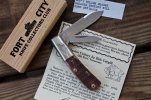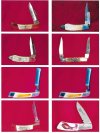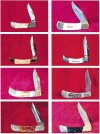Cargill used stainless on the specialty knives like the 4th Anniversary piece and the Tribe knife as an example. The rest of them are all high carbon steel. Which particular steel I don't know. It wasn't that big of an issue
35 years ago. Most people couldn't tell the difference between one steel or another then and certainly not now. It is an issue to argue over and that's about it.
If you read thru the Smoke Signals I post you will get a better understanding of what Cripple Creeks are all about. Even the Smoke Signals are rare. The ones I will post are probably the only ones made in 1983-86.
They took a lot of time away from Cargill when he could be in the shop making knives. For this reason the Smoke Signals didn't continue for long. In time, I will be posting pages from a catalog of a large
collection that gives about as much information about Cripple Creeks out there. There are a few books that document the knives up to a certain point.
Keep in mind, the only knives Cargill did in large quantities were the Knife World knives and the NKCA knives as examples. The majority of Cripple Creeks were limited to small quantities. There is no rule
of thumb. For instance, there are 100 of a particular Trapper made and only 10 of another. Pearl Cripple Creeks outside of the Anniversary and NKCA knives only amount to about 3% of the knives.
Glad you like the Barlow Bugdoc.
More later.
Greg
Well, Greg, I doubt most people would have been able to actually be aware of the different sorts of steel, except by their effects.
One of the great differences in steels is, of course, their ability, or lack of ability, to hold an edge or work on various other materials. The original stain less steels were less able to maintain an edge, which is why knife makers, and I'm talking about the kitchen knife people, here, as well, shunned it for making their knives for the longest period of time (and, I wrote stain less intentionally, since such steels are subject to "staining" and the like, excepting LESS than other steels). Of course, I don't know what high carbon steel Bob was using, but I do know of the one case of his using the 440C stain less. As I recall, the 440 series of stainless steels were able to be hardened to 58-60 on the Rockwell scale. On the other hand the tool steels are able to be made harder than that, up to about 65 on the Rockwell scale. Cecil Pharr, who designed the Browne & Pharr take apart knife, used O1 tool steel, and designed the knife because he and his partner could not get a knife that would hold a decent edge for them. Glenn Marshall, of Mason, Texas, was preferential to O2 tool steel, which, from what I've been able to find, is quite similar to the O1 (which, I guess would seem to follow!). The key with tool steels, of course, is their very name: TOOL steel. That is to say, they are used to make tools for working other materials.
There major advantage of the stainless steels is, of course, that the need less attention for their appearance sake. (Which, of course, is the reason Cecil Pharr made his knife a take-apart--easy to keep clean! (Of course, half the people who get one of his knives don't bother to keep it clean in any case!0
Of course, the joker in all of it is that Bob also experimented with other materials, such as K-6 Stellite, whic) seems to have advantages of both the tool steels and the stainless steels, albeit with a higher price tag, certainly.
(Oh, yes, if you didn't know, the Rockwell scale is based upon indentation that can be made into something by a particular load of stress.)
















